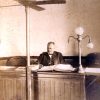calsfoundation@cals.org
Thomas Johnson (1808–1878)
Thomas Johnson, a lawyer who was born and reared in Maryland, moved to Arkansas in 1835, a year before it became a state, and became a decisive figure in the early development of the state’s legal systems. He was a prosecuting attorney, a circuit judge, attorney general of Arkansas, and the second chief justice of the Arkansas Supreme Court, all in the formative stages of the judicial system in the frontier state.
Modest, unassuming, and almost shy by contemporary accounts, Johnson was an anachronism in the boisterous politics of the frontier, where flamboyance and audacity were the tools of political success, including in the courts. His success in gaining political office owed less to his oratorical abilities and more to his being a Democrat in the political intrigues that led eventually to secession and the Civil War.
H. Thomas Johnson was born on December 29, 1808, at Salisbury, Maryland. Nothing is known of his parentage and upbringing except that he entered the practice of law and moved to St. Louis, Missouri, in the fall of 1834 and practiced law there briefly. The next year, he moved to Batesville (Independence County) when it became clear that the territory of Arkansas would enter the union in 1836 as a slave state in tandem with Michigan as a free state. He was appointed prosecuting attorney for the territorial third circuit in northeastern Arkansas in October 1835 and served three months.
In January 1839, he married Louisa Crease, whose family had close ties to “The Family,” the political dynasty that dominated the state’s politics the first quarter-century of statehood. It was likely a key to his future political fortunes. His wife’s sister married George C. Watkins, who later would succeed Johnson as chief justice. Johnson and his wife had four children.
In 1840, Johnson was elected judge of the Third Circuit in northeastern Arkansas. Four years later, the Arkansas General Assembly elevated Johnson, a Democrat, to chief justice of the Arkansas Supreme Court over the first chief justice, Daniel Ringo, a Whig who was sympathetic to the Real Estate Bank of Arkansas. The bank would be shut down three years after Johnson left the court. Johnson served as chief justice for eight years, a period when much of the court’s work was dealing with procedural and technical aspects of jurisprudence.
Johnson was the three-judge court’s workhorse for those eight years because the other members served only short periods. The court had developed a large backlog of cases by the time he left the court in 1853. The court reported 804 opinions in his eight years, but they dealt mainly with jurisdictional and procedural questions. Johnson frequently overturned lower-court decisions on slight technical grounds. For example, in Semon, et al. v. Hill, 7 Ark. 70 (1846), a dispute over a bond executed to the administrator of Semon’s estate, Johnson said the lower court erred in ruling in the estate’s favor and requiring the bond holder to pay $250 to the administrator of the estate because in the legal proceedings filed in the court, Semon’s name was once spelled with an “s” on the end—Semons. “Judgment reversed,” Johnson pronounced.
In 1856, Johnson was elected attorney general of Arkansas, serving a single two-year term. After leaving that office, Johnson left his legal career behind and turned to farming near Little Rock (Pulaski County).
Historian of the era John Hallum, who wrote a mammoth biographical history of nineteenth-century Arkansas, described him as a solemn and slender six-foot-tall man with hazel eyes, adding: “There was more fortune than genius or brilliancy in his professional career, but nature did much for him, in impressing the seal of honesty on his life and character.”
Upon his death on March 25, 1878, the Supreme Court adopted a resolution referring to him as a person “of a high order of intellect…and eminently correct in all the relations of life.” In a memorial session of the Supreme Court two months after his death, a eulogy by a judicial colleague, Thomas Fletcher, recalled Johnson’s demeanor on the bench: “Within an apparent cold exterior there glowed a warm and benevolent heart, and, though reticent and disposed to attend to his own business in the walks of private life, was confiding to his true friends.”
Johnson is buried in Mount Holly Cemetery in Little Rock alongside his wife.
For additional information:
Hallum, John. Biographical and Pictorial History of Arkansas, Vol. 1. Albany, NY: Weed, Parsons and Company, 1887.
“In Memoriam.” Arkansas Gazette, May 22, 1878, p. 2.
Looney, Judge J. W. “Brothers-in-Law H. Thomas Johnson and George C. Watkins—the Second and Third Justices of Arkansas.” Arkansas Lawyer 51 (Summer 2016): 34.
Ernest Dumas
Little Rock, Arkansas







Comments
No comments on this entry yet.